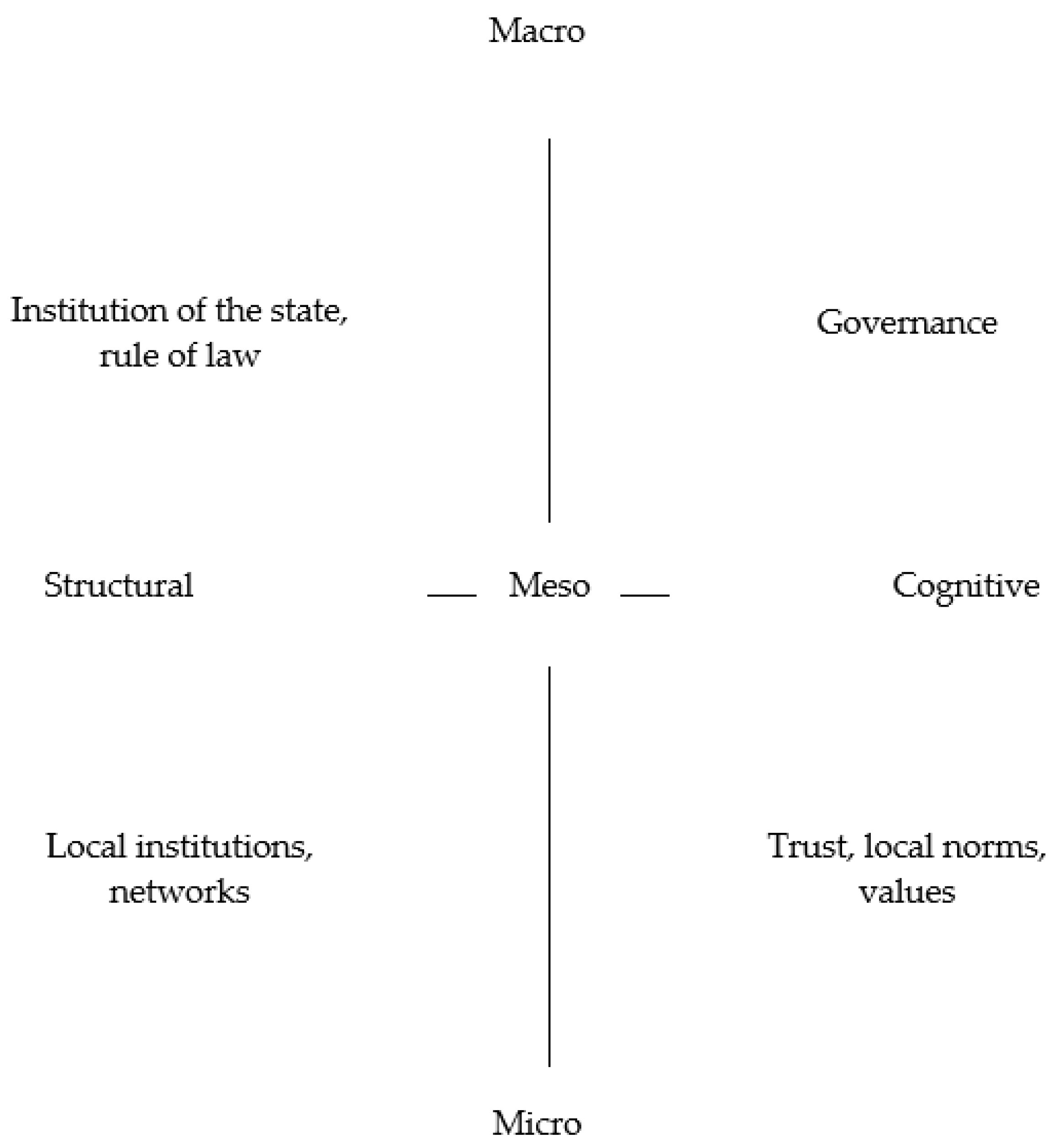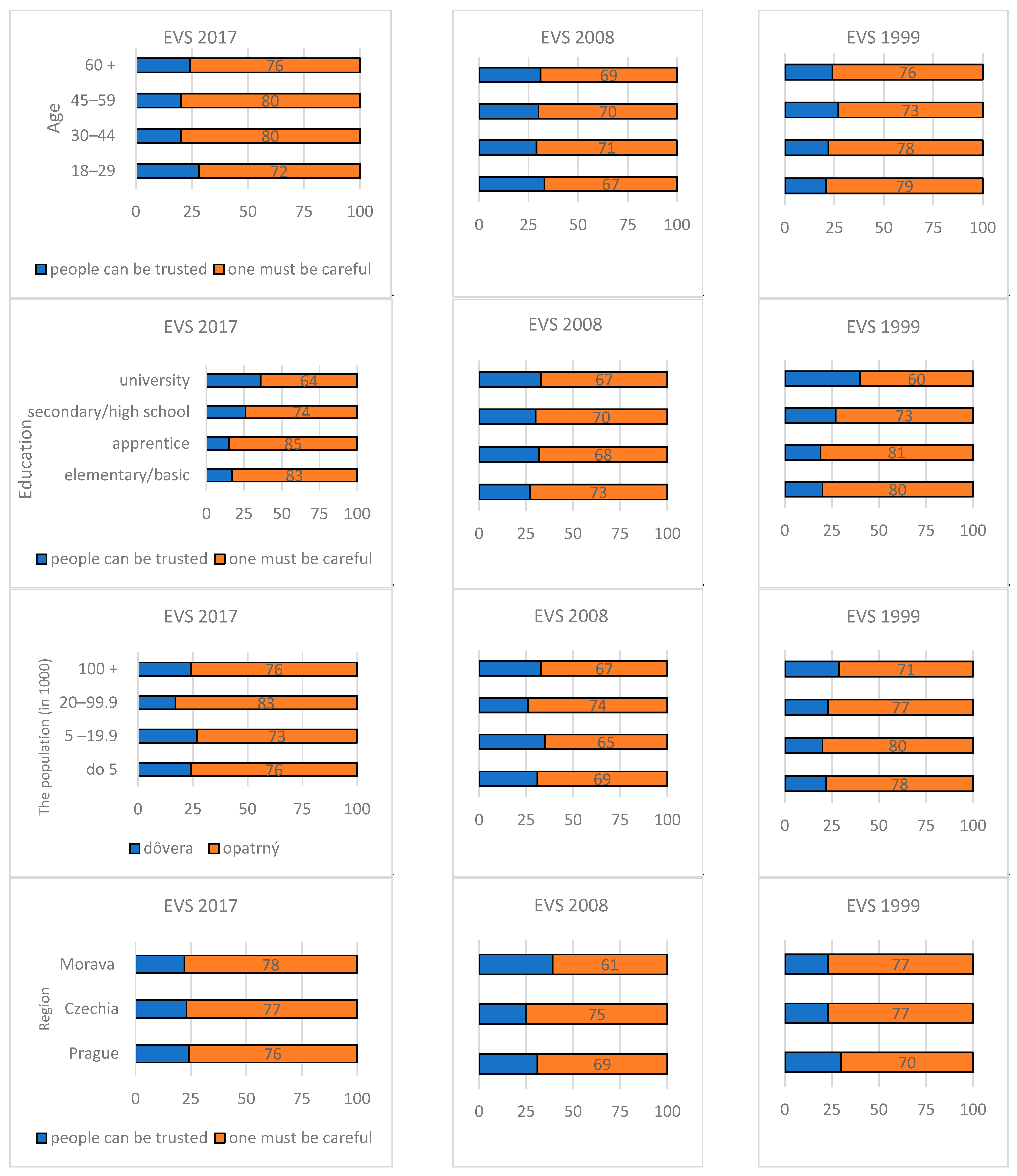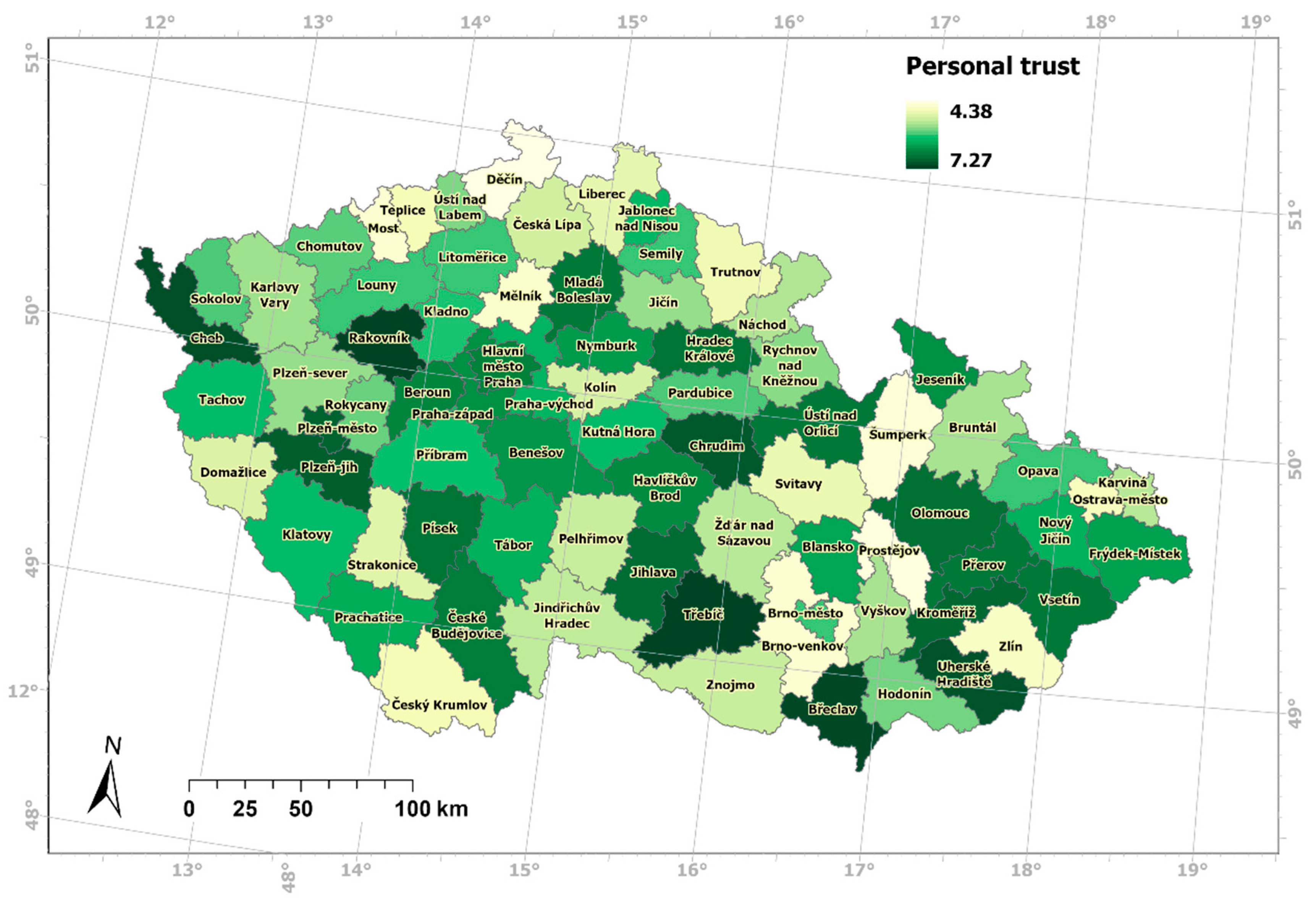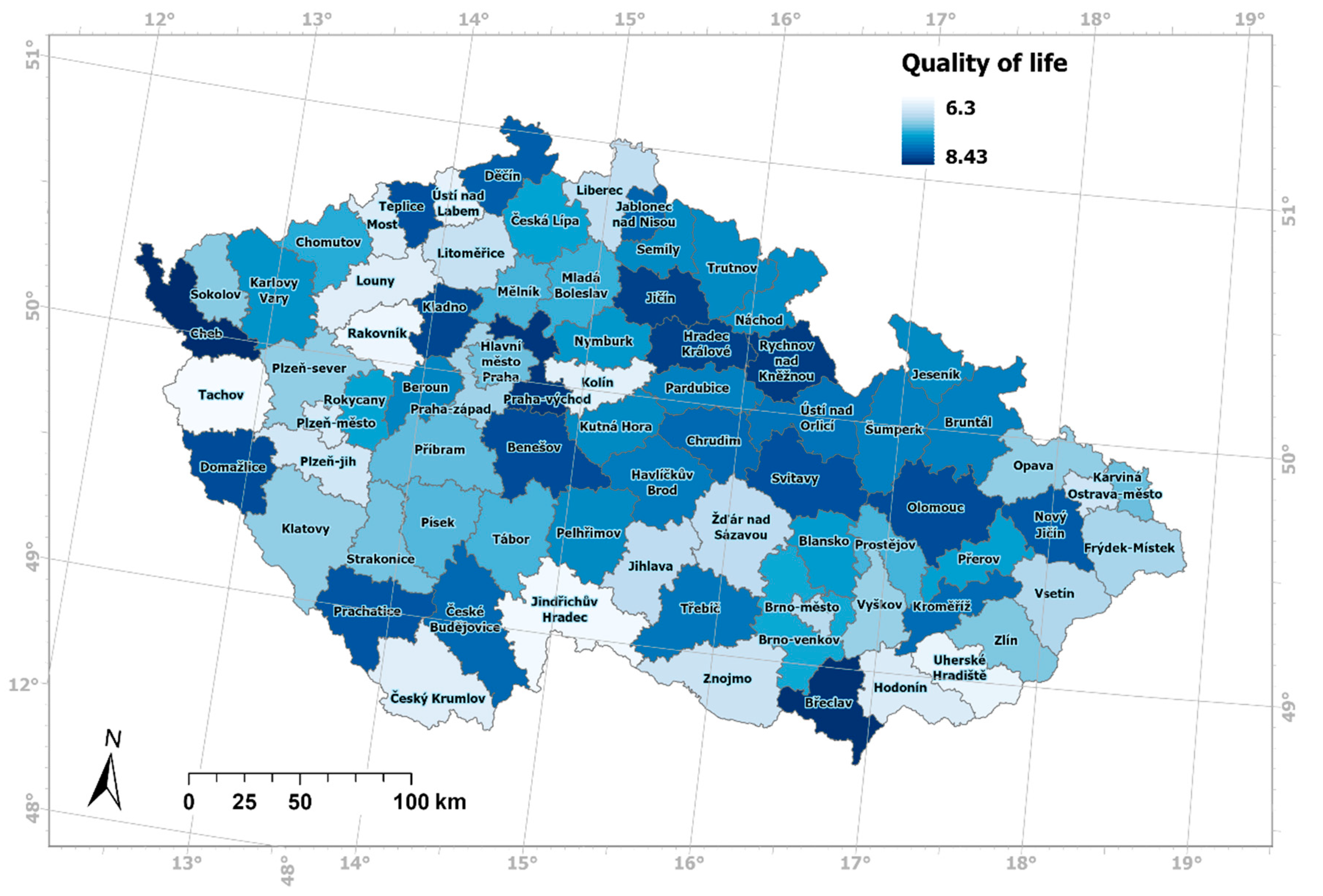Social Capital as a Predictor of Quality of Life: The Czech Experience
Abstract
1. Introduction
2. Theoretical Background
2.1. Social Capital

2.1.1. Linking Social Capital and Quality of Life
2.1.2. Development of Social Capital in Czechia
2.2. Quality of Life
2.3. The Geographical Dimension of the Relationship between Social Capital and Quality of Life
3. Methodology
- -
- At the beginning of the measurement in December 1995, the variable satisfaction with life had a value of 55.7%, neither satisfaction nor dissatisfaction had a value of 32.3%, the variable dissatisfaction had a value of 11.7%, and the variable do not know had a value of 0.3%.
- -
- Between 1996 and 2002, the values for satisfaction, neither satisfaction nor dissatisfaction and dissatisfaction were stagnant.
- -
- In the period 2002–2003, the satisfaction value increased (February 2003—satisfaction 59.8%), the values of neither satisfaction nor dissatisfaction decreased (February 2003—25.8%) and oscillated around 25% until 2020, and the dissatisfaction value increased slightly (February 2003—14.2%) and oscillated around 15% until 2012.
- -
- In 2012, the satisfaction value started to rise, from a value of 51.2% (October 2012) to a value of 69.3% in February 2020. The dissatisfaction value rose to 21.6% in 2012–2013 (October 2013), but since then it has been decreasing.
- -
- In 2020, the satisfaction variable had a value of 69.1%, neither satisfaction nor dissatisfaction a value of 22.4%, the dissatisfaction variable a value of 8.3% and the do not know variable a value of 0.2%.
4. Results and Discussion
5. Conclusions
Author Contributions
Funding
Institutional Review Board Statement
Informed Consent Statement
Data Availability Statement
Conflicts of Interest
References
- Mularska-Kucharek, M. Social Capital and Quality of Life, 3rd ed.; Łódź University Press: Łódź, Poland; Jagellonian University Press: Kraków, Poland, 2014; pp. 1–159. [Google Scholar]
- Cambridge Dictionary. Predictor. Headword. Available online: https://dictionary.cambridge.org/dictionary/english/predictor (accessed on 23 October 2021).
- Tartaglia, S. Different Predictors of Quality of Life in Urban Environment. Soc. Indic. Res. 2012, 113, 1045–1053. [Google Scholar] [CrossRef]
- Leite, A.; Ramires, A.; De Moura, A.; Souto, T.; Marôco, J. Psychological well-being and health perception: Predictors for past, present and future. Arch. Clin. Psychiatry 2019, 46, 53–60. [Google Scholar] [CrossRef]
- Anglim, J.; Horwood, S.; Smillie, L.D.; Marrero, R.J.; Wood, J.K. Predicting psychological and subjective well-being from personality: A meta-analysis. Psychol. Bull. 2020, 146, 279–323. [Google Scholar] [CrossRef] [PubMed]
- Mejbel, M.K.; Almsafir, R.; Alnaser, A.S. The Drivers of Quality of Working Life (QWL): A Critical Review. Aust. J. Basic Appl. Sci. 2013, 7, 398–405. [Google Scholar]
- Arrondo, R.; Cárcaba, A.; González, E. Drivers of Subjective Well-Being under Different Economic Scenarios. Front. Psychol. 2021, 12, 1–12. [Google Scholar] [CrossRef] [PubMed]
- Patrício, B.; Jesus, L.M.T.; Cruice, M.; Hall, A. Quality of Life Predictors and Normative Data. Soc. Indic. Res. 2014, 119, 1557–1570. [Google Scholar] [CrossRef]
- Villas-Boas, S.; Oliveira, A.L.; Ramos, N.; Montero, I. Predictors of Quality of Life in Different Age Groups across Adulthood. J. Intergener. Relatsh. 2019, 17, 42–57. [Google Scholar] [CrossRef]
- Mrva, M. Sociálny kapitál a subjektívna pohoda na Slovensku. Sociol. -Slovak Sociol. Rev. 2020, 52, 111–131. (In Slovak) [Google Scholar] [CrossRef]
- Haupts, M.R.; Hardt, C.; Pöhlau, D.; Sczesni, B.; Elias, W.; Langenbahn, H.; Obert, H.J.; Wussow, P.V. Quality of life as a predictor for change in disability in MS. Neurology 2001, 56, 1250–1251. [Google Scholar] [CrossRef]
- Braun, D.P.; Gupta, D.; Staren, E.D. Quality of life assessment is a predictor of survival in non-small cell lung cancer. BMC Cancer 2011, 11, 353. [Google Scholar] [CrossRef]
- Ramos, S.; Prata, J.; Rocha-Gonçalves, F.; Bettencourt, P.; Coelho, R. Quality of Life Predicts Survival and Hospitalisation in a Heart Failure Portuguese Population. Appl. Res. Qual. Life 2017, 12, 35–48. [Google Scholar] [CrossRef]
- Özabacı, N. Quality of life as a predictor of depression. Procedia 2010, 2, 2458–2463. [Google Scholar] [CrossRef]
- Murgaš, F. Can Easterlin’s paradox be applied to the development of satisfaction with life or does the explanation lie in cultural geographical characteristics? Geogr. Časopis/Geogr. J. 2019, 71, 3–14. [Google Scholar] [CrossRef]
- Schmitz, B. Art-of-Living. A Concept to Enhance Happiness, 1st ed.; Springer: Cham, Germany, 2016; pp. 1–196. [Google Scholar]
- Rezaei Niaraki, M.; Roosta, S.; Alimoradi, Z.; Allen, K.A.; Pakpour, A.H. The association between social capital and quality of life among a sample of Iranian pregnant women. BMC Public Health 2019, 19, 1497. [Google Scholar]
- Requena, F. Social Capital, Satisfaction and Quality of Life in the Workplace. Soc. Indic. Res. 2003, 61, 331–360. [Google Scholar] [CrossRef]
- Sarracino, F. Social Capital and Subjective Well-Being Trends: Evidence from 11 European Countries; Università degli Studi di Siena: Siena, Italy, 2009; pp. 1–45. [Google Scholar]
- Rogers, S.H.; Halsted, J.M.; Gardner, K.H.; Carlson, C.H. Examining Walkability and Social Capital as Indicators of Quality of Life at the Municipal and Neighborhood Scales. Appl. Res. Qual. Life 2011, 6, 201–213. [Google Scholar] [CrossRef]
- Gao, B.; Yang, S.; Liu, X.; Ren, X.; Liu, D.; Li, N. Association between social capital and quality of life among urban residents in less developed cities of western China: A cross-sectional study. Medicine 2018, 97, e9656. [Google Scholar] [CrossRef]
- Fan, V.S.; Mahadevan, R. The Role of Social Capital and Remote Chinese Villagers’ Well-Being. Soc. Indic. Res. 2019, 143, 1109–1128. [Google Scholar] [CrossRef]
- Bartolini, S.; Bilancini, E.; Pugno, M. Did the Decline in Social Capital Depress. Americans’ Happiness? Department of Economics, University of Siena: Siena, Italy, 2008; pp. 1–51. [Google Scholar]
- Bartolini, S.; Bilancini, E.; Pugno, M. Did the Decline in Social Connections Depress Americans’ Happiness? Soc. Indic. Res. 2013, 110, 1033–1059. [Google Scholar] [CrossRef]
- Sirgy, J.M. The Psychology of Quality of Life, 3rd ed.; Springer: Cham, Germany, 2021; pp. 1–339. [Google Scholar]
- Murgaš, F.; Petrovič, F. Quality of Life and Quality of Environment in Czechia in the Period of the COVID-19 Pandemic. Geogr. Časopis/Geogr. J. 2020, 72, 261–274. [Google Scholar] [CrossRef]
- OECD. The Well-Being of Nations The Role of Human and Social Capital; OECD: Paris, France, 2001; pp. 1–7. [Google Scholar]
- Kučerová, S. Education towards obtaining various forms of capital. AUc Geogr. 2011, 46, 23–33. [Google Scholar] [CrossRef][Green Version]
- Murgaš, F.; Klobučník, M. Municipalities and Regions as Good Places to Live: Index of Quality of Life in the Czech Republic. Appl. Res. Qual. Life 2016, 11, 553–570. [Google Scholar] [CrossRef]
- Putnam, R.D. Bowling Alone: The Collapse and Survival of American Community; Touchstone Books by Simon & Schuster: New York, NY, USA, 2008; pp. 1–544. [Google Scholar]
- OECD. OECD Guidelines on Measuring Trust; OECD Publishing: Paris, France, 2017; pp. 1–212. [Google Scholar]
- Algan, Y. Trust and social capital. In For Good Measure: Advancing Research on Well-Being Metrics Beyond GDP; Stiglitz, J., Fitoussi, J., Durand, M., Eds.; OECD Publishing: Paris, France, 2018; pp. 283–320. [Google Scholar]
- Jacobs, J. The Death and Life of Great American Cities; Random House: New York, NY, USA, 1961; pp. 1–458. [Google Scholar]
- Sýkora, L.; Matoušek, R. Jak (ne) měřit sociální kapitál? In Proceedings of the XII Mezinárodní Kolokvium o Regionálních Vědách, Bořetice, Czechia, 18–19 June 2009. (In Czech). [Google Scholar]
- Grootaert, C.; van Bastelaer, T. Social Capital: From definition to measurement. In Understanding and Measuring Social Capital: A Multidisciplinary Tool for Practitioners; Grootaert, C., van Bastelaer, T., Eds.; The World Bank: Washington, DC, USA, 2002; pp. 1–16. [Google Scholar]
- Putnam, R.; Leonardi, L.; Nanetti, R. Making Democracy Work: Civic Traditions in Modern Italy; Princeton University Press: Princeton, NJ, USA, 1993; pp. 1–285. [Google Scholar]
- Pileček, J.; Jančák, V. Can Social Capital Be Measured? An analysis of territorial differences among the districts of Czechia. Geografie 2010, 115, 78–95. [Google Scholar] [CrossRef]
- Chappell, N. Social Capital and Health Inequalities. In Encyclopedia of Quality of Life and Well-Being Research; Michalos, A.C., Ed.; Springer: Dordrecht, The Netherlands, 2014; pp. 6021–6024. [Google Scholar]
- Pileček, J. The concept of social capital: An attempt to summarize theoretical and methodological points-of-departure and approaches to its study. Geografie 2010, 115, 64–77. [Google Scholar] [CrossRef]
- Theurer, K.; Wister, A. Altruistic behaviour and social capital as predictors of well-being among older Canadians. Ageing Soc. 2010, 30, 157–181. [Google Scholar] [CrossRef]
- Cambridge Dictionary. Trust. Headword. Available online: https://dictionary.cambridge.org/dictionary/english/trust (accessed on 26 October 2021).
- Parks, C.D.; Joireman, J.; Van Lange, P.A. Cooperation, Trust, and Antagonism: How Public Goods Are Promoted. Psychol. Sci. Public Interest 2013, 14, 119–165. [Google Scholar] [CrossRef]
- Van Oorschot, W.J.H.; Arts, W.A. The social capital of European welfare states: The crowding out hypothesis revisited. Acta Sociol. 2005, 15, 5–26. [Google Scholar] [CrossRef]
- Eriksson, M.; Santosa, A.; Zetterberg, L.; Kawachi, I.; Ng, N. Social Capital and Sustainable Social Development—How Are Changes in Neighbourhood Social Capital Associated with Neighbourhood Sociodemographic and Socioeconomic Characteristics? Sustainability 2021, 13, 13161. [Google Scholar] [CrossRef]
- Dangendorf, F.; Herbst, S.; Reintjes, R.; Kistemann, T. Spatial patterns of diarrhoeal illnesses with regard to water supply structures—A GIS analysis. Int. J. Hyg. Environ. Health 2002, 205, 183–191. [Google Scholar] [CrossRef]
- Valjarević, A.; Filipović, D.; Valjarević, D.; Milanović, M.; Milošević, S.; Živić, N.; Lukić, T. GIS a techniky diaľkového snímania na odhad objemu rosy v Srbskej republike. Meteorol. Apl. 2020, 27, 1–14. [Google Scholar] [CrossRef]
- Havlíček, M.; Skokanová, H.; Dostál, I.; Vymazalová, M.; Pavelková, R.; Petrovič, F. The consequences of establishing military training areas for land use development—A case study of Libavá, Czech Republic. Land Use Policy 2018, 73, 84–94. [Google Scholar] [CrossRef]
- Onyx, J.; Bullen, P. Sources of social capital. In Social Capital and Public Policy in Australia; Winter, I., Ed.; Australian Institute of Family Studies: Melbourne, Australia, 2000; pp. 105–134. [Google Scholar]
- Sarkiunaite, I.; Bartkute, R.; Jasinskas, E.; Dilys, M.; Jurgelenas, S. Link Between Social Capital and Quality of Life. Transform. Bus. Econ. 2012, 11, 139–153. [Google Scholar]
- Jakubcová, A.; Grežo, H.; Hrešková, A.; Petrovič, F. Impacts of flooding on the quality of life in rural regions of Southern Slovakia. Appl. Res. Qual. Life 2016, 11, 221–237. [Google Scholar] [CrossRef]
- Adedeji, A. Social Capital and Migrants’ Quality of Life: A Systematic Narrative Review. J. Int. Migr. Integr. 2019, 22, 87–101. [Google Scholar] [CrossRef]
- Simons, M.; Lataster, J.; Reijnders, J.; Peeters, S.; Janssens, M.; Jacobs, N. Bonding personal social capital as an ingredient for positive aging and mental well-being. A study among a sample of Dutch elderly. Aging Ment. Health 2019, 24, 2034–2042. [Google Scholar] [CrossRef]
- Bartolini, S.; Sarracino, F. Happy for how long? How social capital and GDP relate to happiness over time. Ecol. Econ. 2014, 108, 242–256. [Google Scholar] [CrossRef]
- Oishi, S.; Kesebir, S. Income inequality explains why economic growth does not always translate to an increase in happiness. Psychol. Sci. 2015, 26, 1630–1638. [Google Scholar] [CrossRef]
- Mikucka, M.; Sarracino, F.; Dubrow, J.K. When Does Economic Growth Improve Life Satisfaction? Multilevel Analysis of the Roles of Social Trust and Income Inequality in 46 Countries, 1981–2012. World Dev. 2017, 93, 447–459. [Google Scholar] [CrossRef]
- Pugno, M.; Sarracino, F. Structural changes in economic growth and well-being. The case of Italy’s parabola. MPRA Munich Pers. RePEc Arch. 2019, 1–49. Available online:https://mpra.ub.uni-muenchen.de/94150/ (accessed on 10 March 2022).
- Rabušic, L.; Chromková Manea, B.-E. Hodnoty a Postoje v České Republice 1991–2017. Pramenná Publikace European Values Study, 1st ed.; Muni Press: Brno, Czechia, 2018; pp. 1–314. (In Czech) [Google Scholar]
- Petrovič, F.; Murgaš, F. Linking sustainability and happiness. What kind of happiness? GeoScape 2020, 14, 70–79. [Google Scholar] [CrossRef]
- Macků, K.; Voženílek, V.; Pászto, V. Linking the quality of life index and the typology of European administrative units. J. Int. Dev. 2021, 34, 145–174. [Google Scholar] [CrossRef]
- Dzúrová, D.; Dragomirecká, E. Quality of life in the Czech Republic. Acta Univ. Carol. Geogr. 2000, 35, 103–116. [Google Scholar]
- Pospěch, P.; Delín, M.; Spěšná, D. Quality of life in Czech rural areas. Kvalita života na českém venkově. Agric. Econ.–Czech 2009, 55, 284–295. [Google Scholar] [CrossRef]
- Kladivo, P.; Halás, M. Quality of life in an urban environment: A typology of urban units of Olomouc. Quaest. Geogr. 2012, 31, 49–60. [Google Scholar] [CrossRef]
- Andráško, I. Kvalita Života v Mestách: Východiská, Prístupy, Poznatky; Masarykova Univerzita: Brno, Czech Republic, 2016. (In Czech) [Google Scholar]
- Mohan, J.; Twigg, L.; Barnard, S.; Jones, K. Social capital, geography and health: A small-area analysis for England. Soc. Sci. Med. 2005, 60, 1267–1283. [Google Scholar] [CrossRef]
- Murgaš, F. Geographical Conceptualization of Quality of Life. Ekológia 2016, 35, 309–319. [Google Scholar] [CrossRef]
- Peiró-Palomino, J. The geography of social capital and innovation in the European Union. Reg. Sci. 2019, 98, 53–73. [Google Scholar] [CrossRef]
- Petrovič, F.; Murgaš, F. Holistic and Sustainable Quality of Life. Conceptualization and Application. Folia Geogr. 2020, 62, 77–94. [Google Scholar]
- Velázquez, G.Á.; Celemín, J.P. Geography and Quality of Life in Argentine Regions: Socioeconomic and Environmental Inequalities. In Handbook of Quality of Life and Sustainability; Martinez, J., Mikkelsen, C.A., Phillips, R., Eds.; Springer: Cham, Switzerland; Berlin/Heidelberg, Germany, 2021; pp. 281–294. [Google Scholar]
- Petrovič, F.; Murgaš, F. Description Relationship between Urban Space and Quality of Urban Life. A Geographical Approach. Land 2021, 10, 1337. [Google Scholar] [CrossRef]
- Faka, A. Assessing Quality of Life Inequalities. A Geographical Approach. Int. J. Geo-Inf. 2020, 9, 600. [Google Scholar] [CrossRef]
- Sarracino, F. Richer in Money, Poorer in Relationships and Unhappy? Time Series Comparisons of Social Capital and Well-Being in Luxembourg. Soc. Indic. Res. 2014, 115, 561–622. [Google Scholar] [CrossRef]
- Sarracino, F.; Mikucka, M. Social Capital in Europe from 1990 to 2012: Trends and Convergence. Soc. Indic. Res. 2017, 131, 407–432. [Google Scholar] [CrossRef]
- Tkáčová, H.; Pavlíková, M.; Jenisová, Z.; Maturkanič, P.; Králik, R. Social media and students’ wellbeing: An empirical analysis during the covid-19 pandemic. Sustainability 2021, 13, 10442. [Google Scholar] [CrossRef]
- Easterlin, R.A. Lost in transition: Life satisfaction on the road to capitalism. J. Econ. Behav. Organ. 2009, 71, 130–145. [Google Scholar] [CrossRef]
- Tokuda, Y.; Jimba, M.; Yanai, H.; Fujii, S.; Inoguchi, T. Interpersonal Trust and Quality-of-Life: A Cross-Sectional Study in Japan. PLoS ONE 2008, 3, e3985. [Google Scholar] [CrossRef][Green Version]
- Šustová, Š. Životní Pohoda Českých Obyvatel; Český Statistický úřad: Praha, Czechia, 2014. (In Czech) [Google Scholar]
- Pekárek, J. Štěstí je krásná věc, dokonce i měřitelná. Statistika a my 2019, 9, 29–30. (In Czech) [Google Scholar]
- CVVM. Satisfaction with Life. 2000. Available online: https://cvvm.soc.cas.cz/media/com_form2content/documents/c2/a5309/f9/ov201030.pdf (accessed on 25 October 2021).
- Markechová, D.; Stehlíková, B.; Tirpáková, A. Štatistické Metódy a Ich Aplikácie; UKF v Nitre, Katedra Matematiky: Nitra, Slovakia, 2011; pp. 1–534. (In Slovak) [Google Scholar]




| Trust in Other People (Line in %) | EVS 2017 | EVS 2008 | EVS 1999 | ||||
|---|---|---|---|---|---|---|---|
| Trust in Other People | Trust in Other People | Trust in Other People | |||||
| People Can Be Trusted | One Must Be Careful | People Can Be Trusted | One Must Be Careful | People Can Be Trusted | One Must Be Careful | ||
| Total | 23 | 77 | 30 | 70 | 24 | 76 | |
| Sex | male | 25 | 75 | 29 | 71 | 23 | 77 |
| female | 21 | 79 | 32 | 68 | 25 | 75 | |
| Age | 18–29 | 28 | 72 | 33 | 67 | 21 | 79 |
| 30–44 | 20 | 80 | 29 | 71 | 22 | 78 | |
| 45–59 | 20 | 80 | 30 | 70 | 27 | 73 | |
| 60+ | 24 | 76 | 31 | 69 | 24 | 76 | |
| Education | basic | 17 | 83 | 27 | 73 | 20 | 80 |
| trained | 15 | 85 | 32 | 68 | 19 | 81 | |
| SS | 26 | 74 | 30 | 70 | 27 | 73 | |
| Uni | 36 | 64 | 33 | 67 | 40 | 60 | |
| Population in thous. | Up to 5 | 24 | 76 | 31 | 69 | 22 | 78 |
| 5–19.9 | 27 | 73 | 35 | 65 | 20 | 80 | |
| 20–99.9 | 17 | 83 | 26 | 74 | 23 | 77 | |
| 100+ | 24 | 76 | 33 | 67 | 29 | 71 | |
| Region | Prague | 24 | 76 | 31 | 69 | 30 | 70 |
| Czechia | 23 | 77 | 25 | 75 | 23 | 77 | |
| Morava | 22 | 78 | 39 | 61 | 23 | 77 | |
| Quality of Life | ||||
|---|---|---|---|---|
| Personal Trust | 1 Low | 2 Medium | 3 High | Total |
| 1 (low) | 4 | 12 | 1 | 17 |
| 2 (medium) | 10 | 32 | 5 | 47 |
| 3 (high) | 5 | 4 | 4 | 13 |
| Total | 19 | 48 | 10 | 77 |
| Quality of Life | ||||
|---|---|---|---|---|
| Personal Trust | Low | Medium | High | Total |
| Low | 5 | 16 | 1 | 22 |
| Medium | 13 | 42 | 6 | 61 |
| High | 6 | 5 | 5 | 17 |
| Total | 25 | 62 | 13 | 100 |
| Districts with the 10 Highest Quality-of-Life Values (a) and Their Trust Values (b) | ||
|---|---|---|
| (a) | (b) | |
| Cheb | 8.43 | 6.73 |
| Břeclav | 8.23 | 7.08 |
| Praha-východ | 8.20 | 6.15 |
| Rychnov n. Kněžnou | 8.18 | 5.82 |
| Hradec Králové | 8.10 | 6.50 |
| Jičín | 8.10 | 5.80 |
| Kladno | 8.05 | 6.05 |
| Benešov | 8.00 | 6.28 |
| Domažlice | 8.00 | 5.45 |
| Olomouc | 8.00 | 6.52 |
| Correlation (a):(b) | 0.48 | |
| Districts with the 10 Highest Trust Values (a) and Their Quality-of-Life Values (b) | ||
|---|---|---|
| (a) | (b) | |
| Třebíč | 7.27 | 7.67 |
| Rakovník | 7.20 | 6.40 |
| Břeclav | 7.08 | 8.23 |
| Cheb | 6.73 | 8.43 |
| Uh. Hradiště | 6.65 | 6.53 |
| Chrudim | 6.64 | 7.86 |
| Plzeň–jih | 6.60 | 6.80 |
| Plzeň–město | 6.55 | 6.78 |
| Kroměříž | 6.54 | 7.85 |
| Jihlava | 6.53 | 6.94 |
| Correlation (a):(b) | 0.11 | |
| Districts with the 10 Lowest Quality-of-Life Values (a) and Their Trust Values (b) | ||
|---|---|---|
| (a) | (b) | |
| Tachov | 6.30 | 6.10 |
| Jindřichův Hradec | 6.36 | 5.64 |
| Rakovník | 6.40 | 7.20 |
| Uherské Hradiště | 6.53 | 6.65 |
| Ústí nad Labem | 6.60 | 5.87 |
| Kolín | 6.67 | 5.50 |
| Český Krumlov | 6.70 | 5.20 |
| Louny | 6.70 | 6.00 |
| Hodonín | 6.77 | 5.88 |
| Most | 6.77 | 5.00 |
| Correlation (a):(b) | −0.54 | |
| Districts with the 10 Lowest Trust Values (a) and Their Quality-of-Life Values (b) | ||
|---|---|---|
| (a) | (b) | |
| Děčín | 4.38 | 7.88 |
| Prostějov | 4.46 | 7.42 |
| Šumperk | 4.79 | 7.64 |
| Brno–venkov | 5.00 | 7.48 |
| Most | 5.00 | 6.77 |
| Mělník | 5.08 | 7.42 |
| Zlín | 5.15 | 7.26 |
| Ostrava | 5.16 | 6.84 |
| Český Krumlov | 5.20 | 6.70 |
| Trutnov | 5.27 | 7.60 |
| Correlation (a):(b) | −0.53 | |
Publisher’s Note: MDPI stays neutral with regard to jurisdictional claims in published maps and institutional affiliations. |
© 2022 by the authors. Licensee MDPI, Basel, Switzerland. This article is an open access article distributed under the terms and conditions of the Creative Commons Attribution (CC BY) license (https://creativecommons.org/licenses/by/4.0/).
Share and Cite
Murgaš, F.; Petrovič, F.; Tirpáková, A. Social Capital as a Predictor of Quality of Life: The Czech Experience. Int. J. Environ. Res. Public Health 2022, 19, 6185. https://doi.org/10.3390/ijerph19106185
Murgaš F, Petrovič F, Tirpáková A. Social Capital as a Predictor of Quality of Life: The Czech Experience. International Journal of Environmental Research and Public Health. 2022; 19(10):6185. https://doi.org/10.3390/ijerph19106185
Chicago/Turabian StyleMurgaš, František, František Petrovič, and Anna Tirpáková. 2022. "Social Capital as a Predictor of Quality of Life: The Czech Experience" International Journal of Environmental Research and Public Health 19, no. 10: 6185. https://doi.org/10.3390/ijerph19106185
APA StyleMurgaš, F., Petrovič, F., & Tirpáková, A. (2022). Social Capital as a Predictor of Quality of Life: The Czech Experience. International Journal of Environmental Research and Public Health, 19(10), 6185. https://doi.org/10.3390/ijerph19106185








